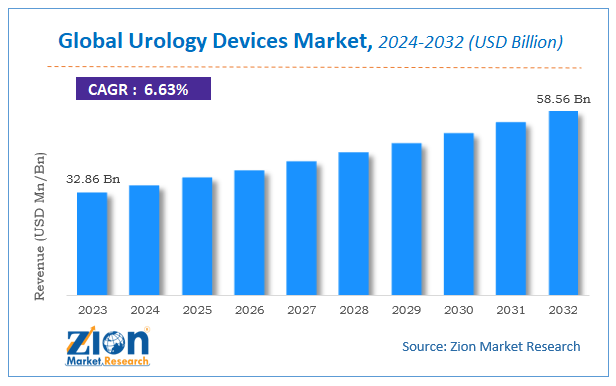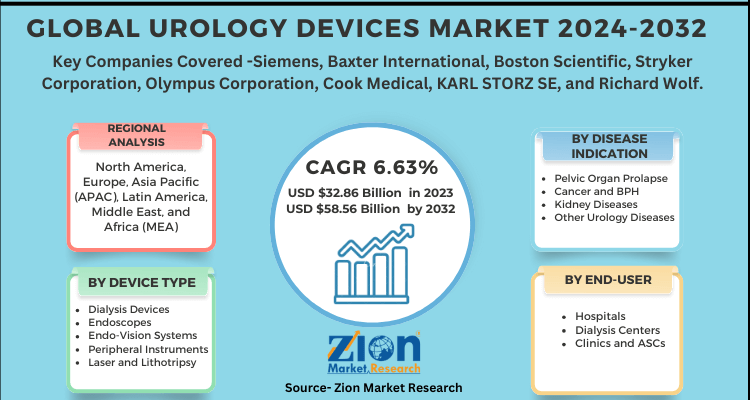Urology Devices Market Size, Share, Industry Analysis, Trends, Growth, 2032

Urology Devices Market by Device Type (Dialysis Devices, Endoscopes, Endo-Vision Systems, & Peripheral Instruments, Laser & Lithotripsy, Robotic Systems, Urodynamic Systems, Biopsy Devices, and Others), by Disease Indication (Pelvic Organ Prolapse, Cancer and BPH, Kidney Diseases, and Other Urology Diseases), and by End-User (Hospitals, Dialysis Centers, Clinics and ASCs, and Others): Global Industry Perspective, Comprehensive Analysis, and Forecast, 2024-2032
| Market Size in 2023 | Market Forecast in 2032 | CAGR (in %) | Base Year |
|---|---|---|---|
| USD 32.86 Billion | USD 58.56 Billion | 6.63% | 2023 |
Urology Devices Industry Perspective:
The Urology Devices Market size was evaluated at USD 32.86 Billion in 2023 and is slated to hit USD 58.56 Billion by the end of 2032 with a CAGR of nearly 6.63% between 2024 and 2032.
The report covers a forecast and an analysis of the urology devices market on a global and regional level. The study provides historical data from 2018 to 2022 along with a forecast from 2024 to 2032
based on revenue (USD Million). The study includes drivers and restraints of the urology devices market along with their impact on the demand over the forecast period. Additionally, the report includes the study of opportunities available in the urology devices market on a global level.
In order to give the users of this report a comprehensive view of the urology devices market, we have included a competitive landscape and an analysis of Porter’s Five Forces Model for the market. The study encompasses a market attractiveness analysis, wherein all the segments are benchmarked based on their market size, growth rate, and general attractiveness.
Urology Devices Market: Overview
Urology is a medicine branch that deals with the treatment and diagnosis of urinary tract diseases and reproductive system conditions. The urogenital system eliminates the body waste, regulates blood pressure, blood pH, and blood volume, controls electrolytes and metabolites, and helps with reproduction. Majority of the global population is affected by urinary tract infections, urinary incontinence, and various other conditions. These devices help in the treatment of such conditions. These urology disorders are diagnosed and treated with the help of biochemical blood tests, pharmaceutical medications, urinalysis, and conventional and minimally invasive surgeries. These devices consist of catheters, drainage bags, guide wires, dilators, and stents. As the urinary tract disorders are increasing, there is a tremendous shift toward minimally invasive surgeries for better patient recovery.
The report provides company market share analysis to give a broader overview of the key players in the market. In addition, the report also covers key strategic developments of the market including acquisitions & mergers, new technology launch, agreements, partnerships, collaborations & joint ventures, R&D, and regional expansion of major participants involved in the market on a global and regional basis. Moreover, the study covers price trend analysis and product portfolio of various companies according to regions.
Urology Devices Market: Growth Factors
There are various factors expected to support the growth of the global urology devices market in the future, such as increasing healthcare expenditure globally. Over the last few years, there have been various changes related to the treatment methodology, specifically the type of diagnosis and treatment of urological diseases. The rising obese population, increasing prevalence of kidney failures, and growing adoption of non-invasive technology has also boosted the urology devices market globally. Shock wave lithotripsy devices that aid in locating kidney stones are the newest trend in the urology devices market. However, stringent regulations for the approval of urology devices use and the high cost of these devices may restrain the urology devices market in the future.
The urology devices market is experiencing significant growth, driven by several factors that reflect the increasing demand for advanced medical technologies in the diagnosis and treatment of urological conditions. Key growth factors include:
-
Rising Prevalence of Urological Disorders: The increasing incidence of urological conditions such as urinary tract infections (UTIs), kidney stones, bladder control problems, and prostate cancer is a primary driver of market growth. As the global population ages, the prevalence of these disorders is expected to rise, leading to greater demand for urology devices.
-
Technological Advancements: Continuous innovation in urology devices, including the development of minimally invasive surgical instruments, advanced imaging systems, and robotic-assisted surgeries, is propelling the market. These technologies offer improved patient outcomes, reduced recovery times, and greater precision in urological procedures, increasing their adoption.
-
Aging Population: The growing elderly population is more susceptible to various urological conditions, including benign prostatic hyperplasia (BPH) and urinary incontinence. This demographic shift is a significant factor driving the demand for urology devices, as older adults are more likely to require medical interventions for these conditions.
-
Increased Awareness and Early Diagnosis: Rising awareness about urological health, combined with improvements in diagnostic tools and screenings, is leading to earlier detection of urological conditions. Early diagnosis often necessitates the use of specialized urology devices for treatment, thus driving market growth.
-
Growth in Surgical Procedures: The increasing number of urological surgeries, such as prostatectomies, nephrectomies, and cystectomies, is contributing to the demand for urology devices. The growing trend towards minimally invasive procedures, which require sophisticated devices, is further supporting market expansion.
-
Expansion of Healthcare Infrastructure: The development and expansion of healthcare facilities, particularly in emerging markets, are contributing to the growth of the urology devices market. Improved access to healthcare services and increased investments in healthcare infrastructure are facilitating the adoption of advanced urology devices in these regions.
-
Favorable Reimbursement Policies: In many countries, favorable reimbursement policies for urological procedures and devices are making these treatments more accessible to patients, thus driving market growth. Insurance coverage for urological treatments encourages patients to seek medical intervention, increasing the demand for urology devices.
-
Increase in Lifestyle-related Diseases: The rise in lifestyle-related diseases such as diabetes, obesity, and hypertension, which are risk factors for urological disorders, is contributing to the growing demand for urology devices. As these conditions become more prevalent, the need for urological treatments and devices is expected to increase.
-
Research and Development Initiatives: Ongoing research and development in the field of urology are leading to the introduction of new and improved devices. Companies are focusing on developing innovative products that offer better outcomes, less invasiveness, and enhanced patient comfort, which is expected to drive market growth.
-
Adoption of Telemedicine and Remote Monitoring: The increasing adoption of telemedicine and remote monitoring technologies in urology is also contributing to market growth. These technologies enable better management of chronic urological conditions and post-operative care, leading to higher demand for related devices.
These factors are collectively driving the growth of the urology devices market, with increasing adoption across both developed and emerging healthcare markets. As advancements continue and awareness of urological health grows, the market is expected to expand further in the coming years.
Urology Devices Market: Segmentation
The global urology devices market is segmented into device type, disease indication, and end-user.
Based on device type, the urology devices market includes dialysis devices, endoscopes, endo-vision systems, and peripheral instruments, laser and lithotripsy, robotic systems, urodynamic systems, biopsy devices, and others.
By disease indication, the urology devices market is categorized into pelvic organ prolapse, cancer and BPH, kidney diseases, other urology diseases.
Based on end-user, the market includes hospitals, dialysis centers, clinics and ASCs, and others.
The regional segment, includes the current and forecast demand for North America, Europe, Asia Pacific, Latin America, and the Middle East and Africa with its further division into major countries including the U.S., Canada, Germany, France, UK, China, Japan, India, and Brazil.
Urology Devices Market: Report Scope
| Report Attributes | Report Details |
|---|---|
| Report Name | Urology Devices Market |
| Market Size in 2023 | USD 32.86 Billion |
| Market Forecast in 2032 | USD 58.56 Billion |
| Growth Rate | CAGR of 6.63% |
| Number of Pages | 110 |
| Key Companies Covered | Siemens, Baxter International, Boston Scientific, Stryker Corporation, Olympus Corporation, Cook Medical, KARL STORZ SE, and Richard Wolf |
| Segments Covered | By device type, By disease indication, By end-user and By Region |
| Regions Covered | North America, Europe, Asia Pacific (APAC), Latin America, Middle East, and Africa (MEA) |
| Base Year | 2023 |
| Historical Year | 2018 to 2022 |
| Forecast Year | 2024 - 2032 |
| Customization Scope | Avail customized purchase options to meet your exact research needs. Request For Customization |
Urology Devices Market: Regional Insights
Geographically, North America is expected to lead the global urology devices market over the forthcoming years. This can be due to the high healthcare expenditure both on devices as well as the consumables. The Asia Pacific urology devices market is likely to experience a rapid change in the CAGR in the future, owing to the developing healthcare facilities and the rising awareness about urology devices.
Urology Devices Market: Competitive Space
Some major players of the global urology devices market are
- Siemens
- Baxter International
- Boston Scientific
- Stryker Corporation
- Olympus Corporation
- Cook Medical
- KARL STORZ SE
- Richard Wolf
- And Others
This report segments the global urology devices market as follows:
Global Urology Devices Market: Device Type Analysis
- Dialysis Devices
- Endoscopes
- Endo-Vision Systems
- Peripheral Instruments
- Laser and Lithotripsy
- Robotic Systems
- Urodynamic Systems
- Biopsy Devices
- Others
Global Urology Devices Market: Disease Indication Analysis
- Pelvic Organ Prolapse
- Cancer and BPH
- Kidney Diseases
- Other Urology Diseases
Global Urology Devices Market: End-User Analysis
- Hospitals
- Dialysis Centers
- Clinics and ASCs
- Others
Global Urology Devices Market: Regional Analysis
- North America
- The U.S.
- Europe
- UK
- France
- Germany
- Asia Pacific
- China
- Japan
- India
- Latin America
- Brazil
- Middle East and Africa
Table Of Content
Methodology
FrequentlyAsked Questions
Urology is a medicine branch that deals with the treatment and diagnosis of urinary tract diseases and reproductive system conditions. The urogenital system eliminates the body waste, regulates blood pressure, blood pH, and blood volume, controls electrolytes and metabolites, and helps with reproduction.
There are various factors expected to support the growth of the global urology devices market in the future, such as increasing healthcare expenditure globally. Over the last few years, there have been various changes related to the treatment methodology, specifically the type of diagnosis and treatment of urological diseases.
According to a study, the global urology devices Industry size was $32.86 Billion in 2023 in 2023 and is projected to reach $58.56 Billion by the end of 2032.
The global urology devices market is expected to grow at a CAGR of 6.63% during the forecast period.
North America is expected to lead the global urology devices market over the forthcoming years. This can be due to the high healthcare expenditure both on devices as well as the consumables.
Some major players of the global urology devices market are Siemens, Baxter International, Boston Scientific, Stryker Corporation, Olympus Corporation, Cook Medical, KARL STORZ SE, and Richard Wolf.
The global urology devices market report covers the geographical market along with a comprehensive competitive landscape analysis. It also includes cash flow analysis, profit ratio analysis, market basket analysis, market attractiveness analysis, sentiment analysis, PESTEL analysis, trend analysis, SWOT analysis, trade area analysis, demand & supply analysis, Porter’s five force analysis, and value chain analysis.
RelatedNews
HappyClients
Zion Market Research
Tel: +1 (302) 444-0166
USA/Canada Toll Free No.+1 (855) 465-4651
3rd Floor,
Mrunal Paradise, Opp Maharaja Hotel,
Pimple Gurav, Pune 411061,
Maharashtra, India
Phone No +91 7768 006 007, +91 7768 006 008
US OFFICE NO +1 (302) 444-0166
US/CAN TOLL FREE +1 (855) 465-4651
Email: sales@zionmarketresearch.com
We have secured system to process your transaction.
Our support available to help you 24 hours a day, five days a week.
Monday - Friday: 9AM - 6PM
Saturday - Sunday: Closed






